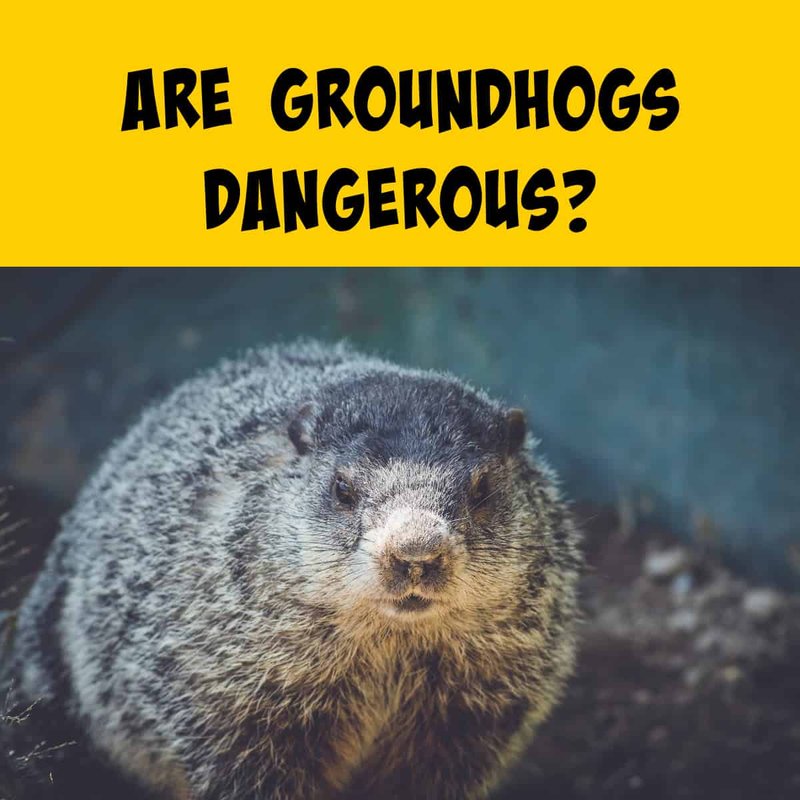
Let’s break it down. Groundhogs, or woodchucks as some call them, are generally more interested in munching on your garden veggies than causing trouble. However, like any wild animal, they can be a bit unpredictable. So, grab a cup of coffee, and let’s explore the ins and outs of whether groundhogs can be dangerous to humans.
Understanding the Groundhog: The Basics
Groundhogs are part of the rodent family and are typically found in North America. They’re about the size of a small dog, weighing between 5 to 14 pounds, and they have a stout body covered with coarse fur. These little guys are primarily herbivores, enjoying a diet of greens, fruits, and vegetables. Imagine a little furry gardener, but instead of planting seeds, they’re more likely to dig up your flowers.
Typically, you’ll find groundhogs in wooded areas, fields, or even your backyard. They’re expert diggers, creating complex burrows that can be several feet deep. During the day, they may be out and about, but they usually retreat to their underground homes when danger approaches. Their burrowing habits can actually lead to some trouble—more on that in a bit.
What Threats Do Groundhogs Pose to Humans?
So, can groundhogs be dangerous? The short answer is yes, but it’s complicated. Generally, they pose minimal risk to humans. However, there are a few situations where you might want to keep your distance. Groundhogs are known for two main things: their sharp teeth and their ability to bite if they feel threatened.
When cornered or trying to protect their young, a groundhog can become defensive. Their bite isn’t typically lethal, but it can hurt, and there’s always the risk of infection. Picture this: you’re just admiring your garden when a groundhog feels trapped and decides to take a nibble out of your hand. Not great!
Injuries from Groundhog Encounters
While groundhogs usually flee rather than fight, an encounter could result in minor injuries. Here are a few types of injuries to consider:
- Bites: Groundhogs have strong jaws, and a bite can break the skin.
- Scratches: If they try to escape quickly, they could scratch you with their sharp claws.
- Falls: If you’re startled by a groundhog and jump back, you could risk falling or tripping.
So, while groundhogs might have a cuddly reputation, it’s essential to understand that they are still wild animals and should be treated with respect.
Groundhogs and Disease: What You Should Know
Another factor to consider when asking if groundhogs can be dangerous is their potential to carry diseases. Like many wild animals, groundhogs can be carriers of certain diseases that could affect humans. For instance, they can have fleas, ticks, and other parasites, which can spread to your pets or even to you.
Additionally, groundhogs are known carriers of *rabies*, though cases are rare. Signs of rabies in animals can include confusion, aggression, and a lack of fear toward humans. If you see a groundhog acting strangely, it’s best to keep your distance and contact animal control or your local wildlife agency.
Preventing Disease Spread
If you live near a groundhog habitat or have one in your yard, here are a few simple precautions to keep in mind:
- Avoid contact: Don’t attempt to handle or feed groundhogs.
- Protect your pets: Ensure your pets are vaccinated and check for ticks regularly.
- Garden safely: Clean up any fruit or scraps around your garden that might attract them.
Taking these steps can help you enjoy your outdoor space while minimizing any potential health risks.
Groundhog Behavior: When to Be Wary
Understanding groundhog behavior can also help you figure out when to keep your distance. Generally, they’re shy creatures, preferring to avoid confrontation. However, during mating season in early spring, they can become more aggressive. This is especially true if they feel their territory is being threatened.
If you see a groundhog acting unusually bold or aggressive, it’s time to step back. You might be wondering how to tell if they’re feeling threatened. Here are a few signs:
- Puffing up: A groundhog might fluff up its fur and make itself look larger.
- Growling or chattering: They can make startling sounds when they’re annoyed.
- Firm stance: If it plants its feet and seems ready to defend itself, don’t push your luck.
Remember, just like people, groundhogs have their moods. If you sense a bad vibe, it’s best to vacate the area.
How to Coexist with Groundhogs
Coexisting with groundhogs isn’t only possible—it can be pretty pleasant! If they’re in your yard, you might find them amusing (at a safe distance, of course). But if you’re worried about your garden, there are ways to keep them from munching on your plants without harm.
One effective strategy is to set up barriers. Here are a few ideas:
- Fencing: Use a sturdy fence that’s buried a foot underground and at least three feet high to keep groundhogs out.
- Repellents: Certain smells, like citrus or garlic, can deter groundhogs.
- Companion planting: Some plants are unappealing to groundhogs—like marigolds—so consider mixing them into your garden.
By using a combination of these methods, you can enjoy your outdoor space while keeping groundhogs at bay.
When to Contact Professionals
If you find yourself facing a groundhog problem that’s hard to manage, consider reaching out to a wildlife control professional. They have the experience and tools necessary to handle these situations safely.
Professional help particularly comes in handy if you encounter a sick or injured groundhog. These animals might need care, and trained individuals know what to do.
When you contact a professional, make sure to ask about their methods. It’s best for the animal, and for your peace of mind, to have humane options in mind, like relocation.
In summary, groundhogs are generally not dangerous to humans. Most encounters lead to cute moments or minor frustrations in the garden, not serious threats. However, being cautious is wise. Remember, these animals are wild and unpredictable, just like any other creature in nature.
If you ever find yourself in a close encounter with a groundhog, just take a breath and keep your distance. Understanding their behavior and knowing how to coexist with them can make your experience much more pleasant.
So, next time you spot a groundhog, think twice before reaching for your phone to snap a photo—your fingers might be safer back in your pocket!

